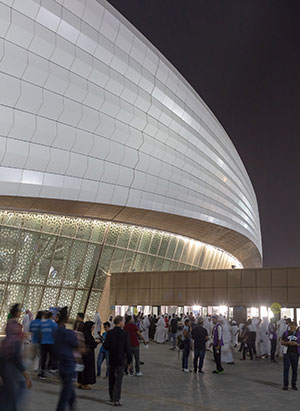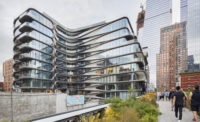With the 2022 FIFA World Cup imminent, Qatar is on a tear to reshape its capital, Doha, building not only stand-out architecture but also legacy infrastructure that will shape the city for decades. The Cup will attract tens of thousands of spectators to Doha and some 3.5 billion to their TV sets. Vast oil revenues have been funding an intense building program to bring this historically underdeveloped country into the 21st century, and to further its aspirations for a prominent place on the world stage—particularly now when Qatar has been politically isolated by its Middle East neighbors.
The recently opened National Museum of Qatar by Jean Nouvel, the Qatar National Library by Rem Koolhaas, and The Qatar National Convention Center by Arata Isozaki have joined I.M. Pei’s now classic Museum of Islamic Art (2008) as emblems of international cultural status. But beyond the iconic architecture, planners aspire to develop and celebrate public space and infrastructure. Beneficiaries of these public works already include the 2.3 million expatriates, mostly foreign workers, who form the vast majority of Qatar’s 2.6 million population, and who already use some of the new facilities, such as the nascent subway. (The international spotlight on World Cup-related construction projects has pressured the government to recently mandate improved conditions for most of those workers.)

Photo © Luke Hayes
Anyone who flew into Qatar last week to attend the inauguration of the 40,000 seat Al Wakrah Stadium, designed by the late architect Zaha Hadid, stepped into an ecosystem of design that starts at the 2014 Hamad International Airport, a lyrical and monumental structure by HOK: its wave-like steel roof recalls the desert-faring and sea-faring history of this peninsular nation. A new super highway landscaped in drought-tolerant vegetation glides the visitor into Doha, where in the Msheireb district, a vast, sustainable, mixed-use urban regeneration project, master-planned by the British firm Allies and Morrison, is underway in the old part of the city.
At the edge of this planned smart development, Amsterdam’s UN Studio has designed the light-filled Msheireb subway station, part of the firm’s ongoing work for Doha’s new city-wide Metro network. The concrete shell structure covers a concatenation of voluminous spaces under Roman-scale vaulted ceilings that cascade to the train platforms below. Last Thursday, thousands of soccer enthusiasts—including a surprise rider: Qatar’s ruler, Emir H H Sheikh Tamim bin Hamad Al Thani—boarded the Metro’s brightly lit trains to get to the Al Wakrah stadium station for the Emir Cup, the kick-off game.
Hadid’s stadium is the first of six new venues in Qatar, all intended for the 2022 FIFA World Cup but tailored for an urban afterlife. Hadid designed Al Wakrah so the entire upper tier of 20,000 seats can be dismantled after the World Cup (ideally to be recycled in another sports facility).
Hadid, who died in 2016, actively participated in the design when her firm partnered with Aecom in 2014, to compete for the stadium.
The client brief was unusual for expressing poetic intentions—stipulating that the design recall in some way dhows, traditional sailing vessels, once beached at Wakrah, originally a small fishing and pearling town before oil transformed the country after the World War II. Hadid and her design team, including project director Jim Heverin and project architect Johannes Hoffmann, mixed the metaphor with others in a visual abstraction that collapsed notions of hulls, folded sails, and even oysters into a shell-like structure. Unlike many stadia that are imposing pieces of static design, Hadid’s dynamic structure, covered in flowing rows of aluminum panels, touches the landscape lightly.
The brief also required that the stadium be playable on afternoons in July, when temperatures peak at an average of 108 degrees. For shade, Hadid turned the shells over, covering the bleachers while opening a long oculus over the pitch below. A sail-like fabric can be drawn on cables to close the stadium. The space is air conditioned prior to a game, with temperatures remaining comfortable during the course of play.
The visual metaphor of a dhow was fortuitous for Hadid, who, since the beginning of her career, created fluid forms and spaces that became even more liquid when the computer arrived in her practice around 2000. At Al Wakrah, she segmented the shell into symmetrical quadrants striated with pleats of aluminum panels, the lines making graphic the shell’s swelling and tapering forms. One end of the asymmetrical carapace cantilevers beyond a shadowy glass enclosure below, appearing to float as it slopes toward the other end, where it grazes the ground. The architects designed the sidewalls to curve into the roof, giving the illusion that the surfaces are continuous.
For the next two years, the grace of the shells will be partially obscured because of temporary one-story, glass-paneled service pavilions necessary for handling the 2022 crowds.
Though their Aecom colleagues scrupulously respected the exterior of the shell as the project went into design/build development, some of the interior details were eliminated in value engineering. The structure was originally designed as a hybrid of covered steel trusses and glulam beams (the wood recalling ribs of a hull), but the engineers converted the structure entirely to steel, and removed the metal panels cladding the long-span steel trusses. Hadid never exposed structure, preferring to keep the dynamic lines clean, to enhance the impression that the buildings seem to levitate. The interior of the shell, as a result, takes on a more mundane mechanical look.
Still, the soaring structural lines Hadid drew across the space survive intact, and the dimensions of the stadium, with seating designed tight to the pitch for intimacy, remain. The saddleback contours of the bowl’s rim add to the sweeping lines of the interior. The sheltering shells not only protect the spectators but also give the immense volume a sense of containment. The space may be voluminous, but Hadid’s design amplifies the immediacy of the event, and the building intensifies the action on the field. Game on.











Post a comment to this article
Report Abusive Comment